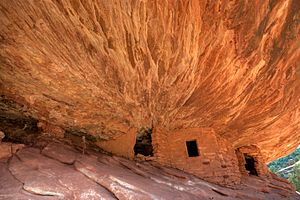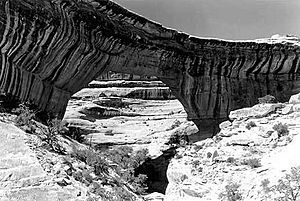San Juan County, Utah facts for kids
Quick facts for kids
San Juan County
|
|
|---|---|

San Juan County Courthouse, Monticello
|
|

Location within the U.S. state of Utah
|
|
 Utah's location within the U.S. |
|
| Country | |
| State | |
| Founded | February 17, 1880 |
| Named for | San Juan River |
| Seat | Monticello |
| Largest city | Blanding |
| Area | |
| • Total | 7,933 sq mi (20,550 km2) |
| • Land | 7,820 sq mi (20,300 km2) |
| • Water | 113 sq mi (290 km2) 1.4% |
| Population
(2020)
|
|
| • Total | 14,518 |
| • Estimate
(2023)
|
14,358 |
| • Density | 1.83008/sq mi (0.70660/km2) |
| Time zone | UTC−7 (Mountain) |
| • Summer (DST) | UTC−6 (MDT) |
| Congressional district | 3rd |
San Juan County (/sæn ˈwɑːn/ SAN-wahn) is a county in the southeastern portion of the U.S. state of Utah. As of the 2020 United States Census, the population was 14,518. Its county seat is Monticello, while its most populous city is Blanding. The Utah State Legislature named the county for the San Juan River, itself named by Spanish explorers (in honor of Saint John).
San Juan County borders Arizona, Colorado, and New Mexico at the Four Corners.
Contents
History
The Utah Territory authorized the creation of San Juan County on February 17, 1880, with territories annexed from Iron, Kane, and Piute counties. There has been no change in its boundaries since its creation. Monticello was founded in 1887, and by 1895 it was large enough to be designated the seat of San Juan County.
Geography
San Juan County lies in the southeastern corner of the state of Utah. Its borders coincide with the borders of the states of Colorado, New Mexico, and Arizona with Utah. The convergence point of these borders, Four Corners Monument, is located at the extreme southeastern corner of the county.
The county's terrain generally slopes to the west and the south, with its highest point, Mount Peale, at 12,726 feet (3,879 m) above sea level. The county has a total area of 7,933 square miles (20,550 km2), of which 7,820 square miles (20,300 km2) is land and 113 square miles (290 km2) (1.4%) is water. It is the largest county by area in Utah.
The county's western and southern boundaries lie deep within gorges carved by the Colorado and San Juan Rivers. Tributary canyons, cutting through rock layers of the surrounding deserts, have carved the land up with chasms, cliffs, and plateaus. In the center of the county is Cedar Mesa, Comb Wash, Natural Bridges, and Hovenweep National Monuments. Canyonlands National Park lies mainly within the county borders. The Eastern side of Glen Canyon National Recreation Area / Lake Powell is also in the county.
The Blue (Abajo) Mountains and the La Sal Mountains exceed 12,000 feet (3,700 m) in elevation. Both ranges are covered with lush forests, contrasting the scenery below. The elevation change within the county is from nearly 13,000 feet (4,000 m) in the La Sal Mountains to 3,000 feet (910 m) at Lake Powell, a difference of about 10,000 feet (3,000 m).
The county's towns lie primarily on a north-south axis along U.S. routes 191 and 163 from La Sal in the north to Monument Valley in the south.
Natural resources

In 2018, the only operating uranium processing plant in the United States was located in the town of Blanding; however, the plant was moved to be on standby in 2019.
San Juan County is home to numerous oil and gas fields, including Squaw Canyon Oil Field, that produce primarily from the Desert Creek and Ismay Formations.
Major highways
 US-163
US-163 US-191
US-191 US-491
US-491- SR-46
- SR-95
- SR-162
- SR-261
- SR-276
Adjacent counties

- Grand County - north
- Mesa County, Colorado - northeast
- Montrose County, Colorado - northeast
- San Miguel County, Colorado - east
- Dolores County, Colorado - east
- Montezuma County, Colorado - east
- San Juan County, New Mexico - southeast
- Apache County, Arizona - south
- Navajo County, Arizona - south
- Coconino County, Arizona - southwest
- Kane County - west
- Garfield County - west
- Wayne County - west
- Emery County - northwest
San Juan County is bordered by more counties than any other county in the United States, at 14.
Protected areas
- Bears Ears National Monument
- Canyonlands National Park (part)
- Dark Canyon Wilderness
- Edge of the Cedars State Park
- Four Corners Monument Navajo Tribal Park (part)
- Glen Canyon National Recreation Area (part)
- Grand Gulch Primitive Area
- Goosenecks State Park
- Hovenweep National Monument (part)
- Manti-La Sal National Forest (part)
- Monument Valley Navajo Tribal Park (part)
- Natural Bridges National Monument
- Navajo Mountain
- Rainbow Bridge National Monument
- Valley of the Gods

Demographics
| Historical population | |||
|---|---|---|---|
| Census | Pop. | %± | |
| 1880 | 204 | — | |
| 1890 | 365 | 78.9% | |
| 1900 | 1,023 | 180.3% | |
| 1910 | 2,377 | 132.4% | |
| 1920 | 3,379 | 42.2% | |
| 1930 | 3,496 | 3.5% | |
| 1940 | 4,712 | 34.8% | |
| 1950 | 5,315 | 12.8% | |
| 1960 | 9,040 | 70.1% | |
| 1970 | 9,606 | 6.3% | |
| 1980 | 12,253 | 27.6% | |
| 1990 | 12,621 | 3.0% | |
| 2000 | 14,413 | 14.2% | |
| 2010 | 14,746 | 2.3% | |
| 2020 | 14,518 | −1.5% | |
| 2023 (est.) | 14,358 | −2.6% | |
| US Decennial Census 1790–1960 1900–1990 1990–2000 2010 2020 |
|||
As of 2017, San Juan County was the poorest county (per capita) in Utah and one of the poorest in the United States.
2020 census
| Race | Num. | Perc. |
|---|---|---|
|
Native American |
7,186 | 49.49% |
| White (non-Hispanic) | 6,038 | 41.58% |
| Black or African American (non-Hispanic) | 32 | 0.16% |
| Asian | 34 | 0.23% |
| Other/Mixed | 481 | 3.31% |
| Hispanic or Latino | 747 | 5.14% |
According to the 2020 United States census and 2020 American Community Survey, there were 14,518 people in San Juan County with a population density of 1.9 people per square mile (0.7/km2). Among non-Hispanic or Latino people, the racial makeup was 6,038 (41.6%) White, 32 (0.2%) African American, 7,186 (49.5%) Native American, 34 (0.2%) Asian, 51 (0.4%) Pacific Islander, 26 (0.2%) from other races, and 404 (2.8%) from two or more races. 747 (5.1%) people were Hispanic or Latino.
There were 7,269 (50.07%) males and 7,249 (49.93%) females, and the population distribution by age was 4,176 (28.8%) under the age of 18, 8,104 (55.8%) from 18 to 64, and 2,238 (15.4%) who were at least 65 years old. The median age was 34.6 years.
There were 4,649 households in San Juan County with an average size of 3.12 of which 3,397 (73.1%) were families and 1,252 (26.9%) were non-families. Among all families, 2,359 (50.7%) were married couples, 317 (6.8%) were male householders with no spouse, and 721 (15.5%) were female householders with no spouse. Among all non-families, 1,070 (23.0%) were a single person living alone and 182 (3.9%) were two or more people living together. 1,848 (39.8%) of all households had children under the age of 18. 3,708 (79.8%) of households were owner-occupied while 941 (20.2%) were renter-occupied.
The median income for a San Juan County household was $49,690 and the median family income was $57,401, with a per-capita income of $20,088. The median income for males that were full-time employees was $48,259 and for females $34,092. 22.8% of the population and 18.1% of families were below the poverty line.
In terms of education attainment, out of the 9,192 people in San Juan County 25 years or older, 1,313 (14.3%) had not completed high school, 2,801 (30.5%) had a high school diploma or equivalency, 3,316 (36.1%) had some college or associate degree, 1,156 (12.6%) had a bachelor's degree, and 606 (6.6%) had a graduate or professional degree.
2010 census
As of the 2010 United States Census, there were 14,746 people and 4,505 households in San Juan County. The racial and ethnic composition of the population was 50.4% Native American, 45.8% White, 0.3% Asian, 0.2% African American and 2.3% reporting two or more races. 4.4% of the population was Hispanic or Latino of any race.
Communities
Cities
- Blanding
- Monticello (county seat)
Town
Census-designated places
Unincorporated communities
- Eastland
- Ucolo
See also
 In Spanish: Condado de San Juan (Utah) para niños
In Spanish: Condado de San Juan (Utah) para niños


